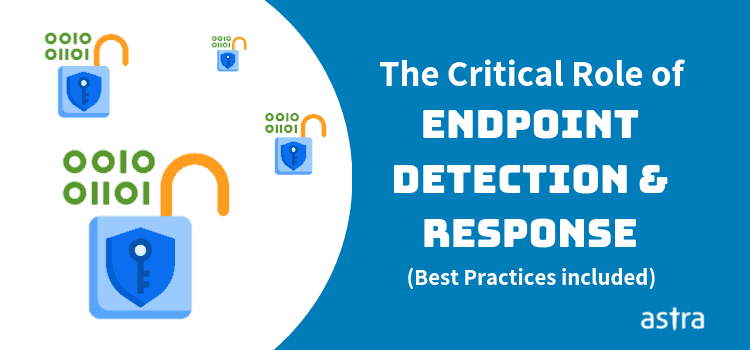Article Summary
Endpoints are not just a means of providing access or services to customers and employees. They are also a potential gateway for attackers to infiltrate your system. Since you cannot simply eliminate endpoints to prevent criminal infiltration, you must instead make sure that they are as secure as possible. One step towards achieving this is adopting an Endpoint Detection and Response (EDR) solution.
Endpoints are not just a means of providing access or services to customers and employees. They are also a potential gateway for attackers to infiltrate your system. Since you cannot simply eliminate endpoints to prevent criminal infiltration, you must instead make sure that they are as secure as possible. One step towards achieving this is adopting an Endpoint Detection and Response (EDR) solution.
What is Endpoint Detection and Response (EDR)?
Endpoint Detection and Response (EDR) solutions are a combination of security tools you can use to secure network endpoints. They collect host-level events for analysis and alert based on rules defined by possible attack scenarios. EDR solutions can help you, monitor, detect and respond to cyber threats and exploits.
EDR solutions use rules called Indicators of Compromise (IOCs) and Behavioral Indicators of Compromise (BIOCs) to detect and stop a variety of threats. This includes privilege escalation, code execution, data exfiltration, file privilege manipulation, lateral network movement and more.
Why Do Organizations Need an EDR Solution?
Traditionally, organizations relied on antivirus tools to provide the bulk of their endpoint security. With them, you only had to worry about standard devices, such as server, laptops, or desktops. Now, however, criminals are using file-less malware, zero-day exploits, and Advanced Persistent Threats (APTs) that antivirus tools are typically unable to detect.
Modern security teams are concerned with protecting a wider range of endpoints. This includes mobile devices, Internet of Things (IoT) devices, digital assistants, smartwatches and more. Often, these endpoints are incompatible with traditional tools. EDR solutions can fill these gaps in protection.
EDR solutions don’t rely on the same detection methods as before and don’t always require the direct deployment of agents on devices. EDR solutions can monitor multiple endpoints simultaneously. They can correlate endpoint activity using behavioural analysis and machine learning technologies, and subsequently recognize a broader range of attacks.
An EDR solution can reduce the Mean Time to Detect (MTTD) and Mean Time to Respond (MTTR). Even if your EDR solutions can’t block an attack, it will continue to collect forensic evidence, such as network events, configuration changes, and file access information. You can then use this information for manual investigations, as well as for post-event analysis.
Endpoint Detection and Response (EDR) Best Practices
Your EDR security solutions will only be effective if implemented properly. To ensure that your systems are as protected as possible, consider adopting some of the following best practices.
1. Don’t ignore users
User activity is one of the greatest risks to any system. Users can do significant damage with either malicious intent or through sheer accident. If a solution is intrusive to user experience, benign users might find workarounds. For example, they can decide to disable defense functionality to improve their experience.
On the other hand, if a solution is too flexible to user requests, it can be easily manipulated by attackers. A good solution should be as transparent as possible to an end-user. When it does require interaction, communications should be clear and direct. The system shouldn’t give away unnecessary system information, such as IP architectures or personal data.
Educating your users on threats and risky behaviors can help increase their awareness of security. It can also prevent liabilities caused by tactics like phishing or social engineering. Periodic trainings or mock threat scenarios can help increase user buy-in for security protocols and speed up the response time when an incident does occur.
2. Integrate with other tools
EDR solutions are meant to protect your endpoints, not your entire system. You need to integrate them with other tools for maximum protection. Combine solutions with patch management and antivirus tools, and implement DNS protection, firewalls, and encryption protocols.

Some EDR solutions, like FireEye, Cisco AMP or Cynet, can be integrated with Security Information and Event Management (SIEM) solutions. These monitor and alert to network-wide issues. Taking advantage of this ability allows you to centralize your tool management. This reduces the chance that alerts go unattended. With centralized logs you can quickly analyze and respond to events.
3. Use network segmentation
Although some solutions can respond to incidents by isolating endpoints, starting with a segmented network will provide better protection. Network segmentation allows you to restrict endpoints to only those services and data stores they are designed to access. It reduces the risk of data loss and contains the amount of damage that a successful attack can accomplish.

The use of Ethernet Switch Paths (ESPs) can further protect your network. They allow you to hide the structure of your network, making it even harder for attackers to move from one segment to another.
4. Take Preventative Measures
You should never rely solely on active responses to threats, but rather combine active response with preventative measures. Ensure that your systems remain fully updated and patched, and use clear protocols and comprehensive dependency lists. Doing so can significantly reduce the number of threats that you need to defend against.
You should do routine audits of your systems to verify that tools and protocols are still appropriately configured and applied. Test your systems and tool functionality by performing threat modelling and penetration testing on a continuous basis.
Consider using deception technologies and Moving Target Defense (MTD) strategies to slow down attackers. These tools can give you more time to respond to an incident and minimize the damage done.

Your preventative measures should include a comprehensive incident response plan that specifies response actors, action protocols and restorative steps. Such a plan will help speed up your incident response time. It will ensure regulatory compliance and provide you with a structure for analyzing collected forensic data after the fact.
5. Use Available Resources
If you are using third-party tools, take full advantage of the support resources provided by your EDR solution vendor. Many companies hold periodic trainings or webinars to keep clients up to date on available features and best practices. Some companies offer mini-courses on a variety of security aspects for free or minimal costs.
Community-based resources and Information Sharing and Analysis Organizations (ISAOs) provide useful tools and resources. Notable community organizations are the National Vulnerability Database (NVD) and the Open Web Application Security Project (OWASP). Their websites are filled with valuable cybersecurity data and insights.
Conclusion
Protecting your endpoints is critical to ensuring that your network remains secure. Adopting an EDR solution can help you secure your data and systems more effectively. This is particularly true if you integrate it with a broader range of network protection tools. To ensure that your assets are well-protected, choose your tools with care, and implement EDR best practices.
















